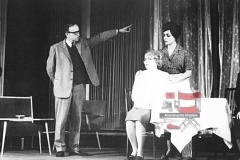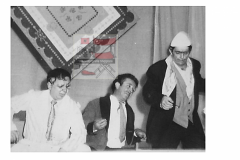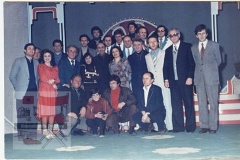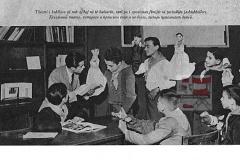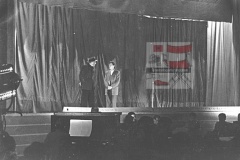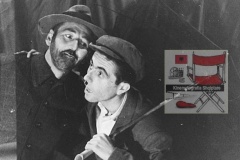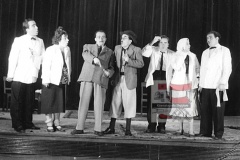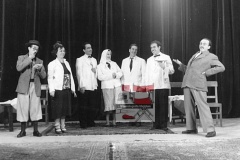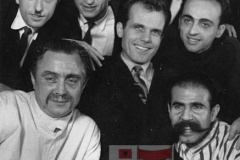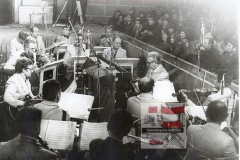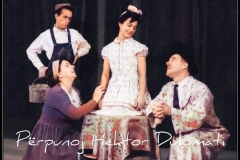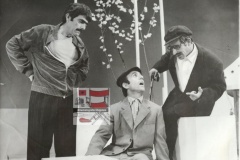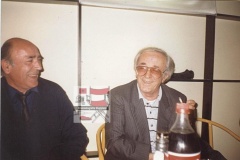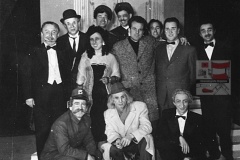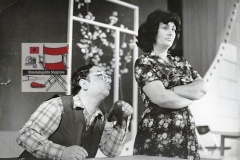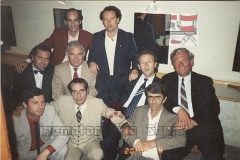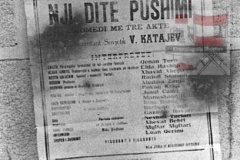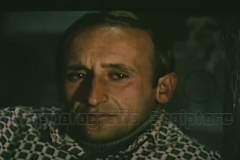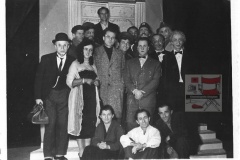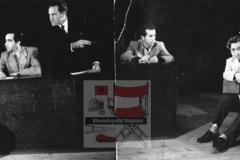Estrada of the State (later of Tirana).
Professional variety theater institution. In 1926, the building of the “Nacional” cinema was built (later 17 Nentori cinema), where, in addition to movies, in the late evenings, after 21:00, when all the movie screenings ended, variety shows were also given.
Especially in the 1930s, Tirana became one of the busiest theater and music circles, with a wide amateur movement that measured progress, qualification, expansion, progress. The theater company “Tirana” (1932), directed by Mihal Popi, Mursin and Xhevat Serezi, Mihal Stefa was a persistent and committed group.
The first part that this company staged was the comedy “The End of the Drink” (adaptation of the comedy “Doctor Padashka by Moliere”). The success was sensational. The company staged an adaptation of Xhevat Serezi, a comedy by Kristo Floqi. Meanwhile, this company “Tirana” also successfully adapts Moliere’s comedies.
The significant expansion of the Amateur Theater Movement in the 20s-30s is proof of the Albanian people’s love for this art. The creation of an institutional infrastructure through the establishment of various theater companies and several cinemas with stages, which also performed the role of theater such as “Nacional”, “Diana” (later called “Gloria”) and “Rozafat”; the organization of competitions, the qualification of future artists – these create the conditions for a significant progress of theater activities in Tirana, an activity now considered as a phenomenon of development and spiritual emancipation of the country.
From the years 1932-1938, a multitude of short pieces, farces, especially comedies, were given on the stages of these three cinemas.
They were warmly welcomed by the viewers in the capital, especially the parts: “The Deaf”, “Two Gentlemen Without Pants”, “The Wicked One”, “The Devil and the Man”.
“Gloria” cinema managed to compete with “Nacional” and “Rozafat” cinemas in providing variety shows. This rich tradition that was inherited, including the years of World War II with the “Partisan Theater”, after the liberation of the country became a premise and incentive, so that with the creation of the State Theater on May 24, 1945, a permanent pop troupe in the country’s capital, Tirana.
A group of comic actors, singers and instrumentalists had created a nucleus, set up near the Executive Committee of Tirana, which would soon become the first professional variety theater troupe. This central group, with elements chosen from the numerous variety groups of enterprises and schools of the city, gave many shows of the variety type with skits, dialogues, imitations, songs, etc.
The director Pandi Stillu staged the comedy “The man who saw death with his eyes” by Viktor Eftimiu with the troupe in question.
At the beginning of 1952, the State Estrada, as it was called at that time, emerged as a professional institution in its own right, although it was included within the basic structure of the Albanian Philarmine that was created in 1949-1950.
On May 2, 1952, it showed the first premiere, Estrada No. 1, directed by Pandi Stillu, composer and conductor Agim Prodani, Muharrem Xhediku, Zef Gruda. In this show, the actors Ramazan Zyberi, Melpomeni Cobani, Enver Dauti, Ana Kcira, Tonin Konci, Ndrek Shkjezi, Skender Plasari and Lin Ndoka stand out.
The pieces “Christopher Columbus on trial” by Nonda Bulka, “Two gangsters” by Dionis Bubani, humorous pieces by Besim Levonja, speed numbers from the beginning by the acrobatic trio: Telat Agolli, Pina Shkurti and Abdyl Karabashi were applauded.
After that, “Estrada no. 2”, “Estrada no. 3” appeared, until in 1954 its premieres began to appear with the titles: “Laugh and one”, “Work and have fun” etc.
The year 1954 marked the institutional separation of the State Estrada from the Albanian Philharmonic, now acting as an independent institution. In its initial mission, Estrada of Tirana, as the most complete variety theater and as the most qualified and selected artistic troupe of the country, has had an important role and access in cultural formation as well as entertaining the viewers. Tirana’s variety show has also served as a school for the creation, training and qualification of variety shows in other districts.
She has played this role all the time until our days, offering the public high levels, as far as humorous writers were concerned , the interpretation of the actors, their artistic profiles, as well as with regard to the well-known musicians and singers that he has produced, orchestrators and other artists of the troupe, helping to cultivate healthy artistic tastes and offering pleasure, joy, relieving people from stress.
As the most successful variety show in the 1950s-1960s, it affirmed such humor artists, with outstanding individuality, as Skender Sallaku, Skender Plasari, Vilson Gjoca, Kujtim Shehu, Vegim Xhani, Xhemal Myftiu and the singers Vace Zela, Anita Take, Paulina Nika, Hajrie Harapi, Pjeter Gjergji.
Its conductors Zef Gruda, Nesti Uci, Koco Uci alongside with the orchestra composed of the pianist Alqi Kareco and the instrumentalists Lulzim Hima, Gasper Curcia, Ymer Qosja, Viktor Filaj etc. became well known for the treatment of the songs, as well as the selection of the repertoire in in general, fulfilling the requests of art lovers.
During the two decades since its creation, in the many premieres that this troup have made, the following are mentioned: “Qesh e njesh” (1954) staged by Besim Levonja; “Radiotelevision” (1957) by Andrea Minga and Melpomeni Cobani, “Miza buall” (1957) by Mihal Popi, “Poshte e lart” (1957) by Nikolla Panajoti, “Kolltuku magjik” (1959) by Enver Duti, “Pinoku” (1965) by Lin Ndoka, “We are three” (1965) by Gjergj Vlashi, “Kerkesa e kohes” (1967), by Milto Profi, “Ah keto marredheniet” (1970) by Bujar Kapexhiu, “Expert i ores 18” by Gjergj Vlashi and Bujar Kapexhiu.
A new rise in quality marks the troupe in the 1970s-1980s with the arrival of young artists, actors and singers, who had graduated from the High Institute of Arts, such as Vasillaq Vangjeli, and later Mexhide Pici, Kosta Kamberi, who were followed by Agim Bajko, Mariana Kondi, Besnik Kasa, Enver Buku, Rita Lati, Xhevahir Zeneli, Shpresa Berdellima, Arben Shaka, Koco Devole, Veli Rada, Met Bega, Behar Mera and singers: Luan Zhegu, Ema Qazimi, Liljana Kondakci, Irma Libohova , Kozma Dushi, etc.
Among her most famous humorous writers were Nonda Bulka, Spiro Comora, Odhise Grillo, Naum Prifti, Tasim Aliaj, Skender Plasari, Koco Devole, Sheri Mita, Filip Cakuli, etc.  In addition to the type of variety shows with short humorous pieces, full comedies, vaudevilles, etc. have been staged on ET’s (Tirana`s Estrada) stage from time to time. Among them, the spectators were eagerly waiting for the following: “The Three Brides” (D. Bubani), ” “Mimosa asked the heart” (N. Prifti), “Merita” (L. Bungo), “Betrothal” (A. Cehov) or fragments from “I semuri per mend” by Moliere, “Don Quixote” by Cervantes, etc.
In addition to the type of variety shows with short humorous pieces, full comedies, vaudevilles, etc. have been staged on ET’s (Tirana`s Estrada) stage from time to time. Among them, the spectators were eagerly waiting for the following: “The Three Brides” (D. Bubani), ” “Mimosa asked the heart” (N. Prifti), “Merita” (L. Bungo), “Betrothal” (A. Cehov) or fragments from “I semuri per mend” by Moliere, “Don Quixote” by Cervantes, etc.
From a general point of view, like all Albanian theatre, Estrada of Tirana was hampered by the violent presence of the declared political tendency and ideology in the treatment of comic events, for this reason its satire, sarcasm, social criticism it was torn towards a predetermined theme, accompanied by preconceived ideas and solutions.
However, many literary materials that were the object of social and family phenomena escaped the “white lines” and operated with a language full of humor, which in fact represent the greatest part of the success of this variety show over the years.
With the establishment of democracy, comedies were shown: “A man with two women”, “Qeflinjte” (Sh. Mita), “The weight of guilt” (I. Bezhani), “The delight of the armchair and the bed”, etc.
Several short comedies by Koco Devole were distinguished for their sharp political edge and whipping satire, such as: “Canta e zeze” (1986), “Revolver” (1994), “Oreksi i madh” (1995) and especially “Hunting of last”.
During the 90s, the shows were also successful: “Variety” performed by B. Kapexhiu, “Hurrate for you” by Kosta Kamberi, “Rrumpalle show” by Sulejman Dibra and Kosta Kamberi.
In national festivals and meetings, Estrada e Tirana has won first prizes several times. She has performed in over 300 premieres and over 100,000 performances, the most in the city of Tirana, but also in other cities of Albania.
Estrada has developed successful tours in various cities in Kosovo, Montenegro, Macedonia, Greece, Switzerland, Turkey and the USA.
In 2004, due to the lack of facilities, Estrada has significantly reduced her activity, performing through the streets of indirectly, waiting for a new theater building.
The staff reached 27 people, including 7 actors, 6 instrumentalists, 1 director, 1 conductor, 1 scenographer, 1 stage inspector, 6 background assistants, administration, etc.
The most complete personnel reached before v. 1991 resulted in a total of 45 people, of these 17 actors, 5 singers, 10 instrumentalists, 1 director, 1 director, 1 conductor, 1 scenographer, 1 director, 7 from the background and administration.
___________
PLEASE NOTE: Any text identical to the above that will appear online outside of this page and after the date of publication here, is considered – COPY – PLAGIARISM, including photos, (with the exception of the authors themselves).
Published for the first time in Albanian Cinematography, January 29, 2020
_____________
Albanian Cinematography in activity since 2013
Reference: “Skender Sallaku or how we laughed in the dictatorship” – Arberi 2002 / P. Kulla; “After the show” – Naim Frasheri 1971 / Miho Gjini; “On the stage of life” – Erik 2006 / Vitore Sallaku; History of Albanian theater – School Book Publishing House 1985, vol 3 / Higher Institute of Arts; “Estrada and variety theater in Tirana” – Stage and Screen vol 1 / 1983-p. 45; “Encyclopedia of Albanian Theater and Cinematography” – Toena 2009 / J. Papagjoni (p. 118-119)
PHOTOS : contribution of the administrators, Myftar Armiri – the official Facebook page, as well as “courtesy of google search”.
Follow us: Blog: https://albaniancinematography.blogspot.com/ Facebook: https://www.facebook.com/ksh.faqjazyrtare Dailymotion: https://www.dailymotion.com/kinetografiashqiptareartisporti YouTube: https://www.youtube.com/channel/UCDRYQ5xCyGkfELm3mX8Rhtw
Discover more from Albanian Cinematography - Sport
Subscribe to get the latest posts sent to your email.

